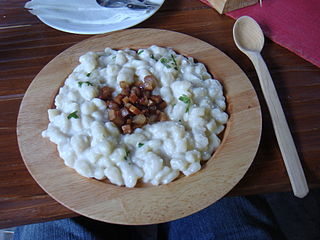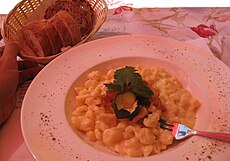
Hungarian or Magyar cuisine is the cuisine characteristic of the nation of Hungary, and its primary ethnic group, the Magyars. Hungarian cuisine has been described as being the spiciest cuisine in Europe This can largely be attributed to the use of their piquant native spice, Hungarian paprika, in many of their dishes. A mild version of the spice, Hungarian sweet paprika, is commonly used as an alternative. Traditional Hungarian dishes are primarily based on meats, seasonal vegetables, fruits, bread, and dairy products.

Finnish cuisine is notable for generally combining traditional country fare and haute cuisine with contemporary continental-style cooking. Fish and meat play a prominent role in traditional Finnish dishes in some parts of the country, while the dishes elsewhere have traditionally included various vegetables and mushrooms. Evacuees from Karelia contributed to foods in other parts of Finland in the aftermath of the Continuation War.

Polish cuisine is a style of food preparation originating in and widely popular in Poland. Due to Poland's history, Polish cuisine has evolved over the centuries to be very eclectic, and shares many similarities with other national cuisines. Polish cooking in other cultures is often referred to as à la polonaise.

Danish cuisine originated from the peasant population's own local produce and was enhanced by cooking techniques developed in the late 19th century and the wider availability of goods during and after the Industrial Revolution. Open sandwiches, known as smørrebrød, which in their basic form are the usual fare for lunch, can be considered a national speciality when prepared and garnished with a variety of ingredients. Hot meals are typically prepared with meat or fish. Substantial meat and fish dishes includes flæskesteg and kogt torsk with mustard sauce and trimmings. Ground meats became widespread during the industrial revolution and traditional dishes that are still popular include frikadeller, karbonader and medisterpølse. Denmark is known for its Carlsberg and Tuborg beers and for its akvavit and bitters, but amongst the Danes themselves imported wine has gained steadily in popularity since the 1960s.

Austrian cuisine is a style of cuisine native to Austria and composed of influences from Central Europe and throughout the former Austro-Hungarian Empire. Austrian cuisine is most often associated with Viennese cuisine, but there are significant regional variations.

Russian cuisine is a collection of the different dishes and cooking traditions of the Russian people as well as a list of culinary products popular in Russia, with most names being known since pre-Soviet times, coming from all kinds of social circles.

Lithuanian cuisine features products suited to the cool and moist northern climate of Lithuania: barley, potatoes, rye, beets, greens, berries, and mushrooms are locally grown, and dairy products are one of its specialties. Various ways of pickling were used to preserve food for winter. Soups are extremely popular, and are widely regarded as the key to good health. Since it shares its climate and agricultural practices with Northern Europe, Lithuanian cuisine has much in common with its Baltic neighbors and, in general, northern countries.

Ukrainian cuisine is the collection of the various cooking traditions of the people of Ukraine, one of the largest and most populous European countries. It is heavily influenced by the rich dark soil (chornozem) from which its ingredients come, and often involves many components. Traditional Ukrainian dishes often experience a complex heating process – "at first they are fried or boiled, and then stewed or baked. This is the most distinctive feature of Ukrainian cuisine".
Romanian cuisine is a diverse blend of different dishes from several traditions with which it has come into contact, but it also maintains its own character. It has been mainly influenced by Turkish but also a series of European cuisines in particular from the Balkan Peninsula and Hungarian cuisine as well as culinary elements stemming from the cuisines of Central Europe.

Jewish cuisine refers to the worldwide cooking traditions of the Jewish people. During its evolution over the course of many centuries, it has been shaped by Jewish dietary laws (kashrut), Jewish festivals and holidays, and traditions centred around Shabbat. Jewish cuisine is influenced by the economics, agriculture, and culinary traditions of the many countries where Jewish communities have settled and varies widely throughout the entire world.
Latvian cuisine typically consists of agricultural products, with meat featuring in most main dishes. Fish is commonly consumed due to Latvia's location on the eastern shore of the Baltic Sea.

Slovak cuisine varies slightly from region to region across Slovakia. It was influenced by the traditional cuisine of its neighbours and it influenced them as well. The origins of traditional Slovak cuisine can be traced to times when the majority of the population lived self-sufficiently in villages, with very limited food imports and exports and with no modern means of food preservation or processing.

Czech cuisine has both influenced and been influenced by the cuisines of surrounding countries and nations. Many of the cakes and pastries that are popular in Central Europe originated within the Czech lands. Contemporary Czech cuisine is more meat-based than in previous periods; the current abundance of farmable meat has enriched its presence in regional cuisine. Traditionally, meat has been reserved for once-weekly consumption, typically on weekends.

Georgian cuisine consists of cooking traditions, techniques, and practices of Georgia. Georgian cuisine has a distinct character, while bearing some similarities with various national cuisines of the South Caucasus, the Middle East and Eastern Europe. Every region of Georgia has its own distinct style of food preparation. Eating and drinking are important parts of Georgian culture.

Israeli cuisine primarily comprises dishes brought from the Jewish diaspora, and has more recently been defined by the development of a notable fusion cuisine characterized by the mixing of Jewish cuisine and Arab cuisine. It also blends together the culinary traditions of the various diaspora groups, namely those of Middle Eastern Jews with roots in Southwest Asia and North Africa, Sephardi Jews from Iberia, and Ashkenazi Jews from Central and Eastern Europe.

Moldovan cuisine is a style of cooking related to the people of Moldova. It consists mainly of ingredients such as various meats, potatoes, cabbage, and a variety of cereal grains. The local cuisine is very similar to Romanian, and also draws inspiration and elements from other cuisines in the region, including Greek, Polish, Ukrainian, and Russian, with a great influence left by the Ottoman cuisine.

Bavarian cuisine is a style of cooking from Bavaria, Germany. Bavarian cuisine includes many meat and Knödel dishes, and often uses flour. Due to its rural conditions and Alpine climate, primarily crops such as wheat, barley, potatoes, beets, carrots, onion and cabbage do well in Bavaria, being a staple in the German diet.
















